Periodontal disease (also called gum disease) is more common than you may think. If you’ve been diagnosed, you can rest easy knowing that your Brush Dental practice team has extensive experience with periodontal disease and has successfully treated many patients.
Did You Know?
Over 75% of Americans suffer from periodontal disease; most don’t even know it.
In this section, you can learn more about periodontal disease and its treatment.
Periodontal treatments depend on the type of gum disease and how severe it is. If the disease is caught early (when it is gingivitis), and no damage has been done to the supporting structures under the teeth, you may simply need professional cleaning. The dental team can give you tips for improving your daily oral hygiene.
Even with these measures, some patients develop more severe periodontal disease. The first step in treating the disease usually involves a special deep cleaning called “scaling and root planing.” In this treatment, the dentist removes plaque and tartar down to the bottom of each periodontal pocket. This treatment may be done over several visits, depending on your needs. The root surfaces of the teeth are then smoothed (or “planed”) to allow the gum tissue to heal and reattach to the teeth. This treatment also may take more than one visit.
Your dentist may recommend medications to help control infection and pain or to aid healing. These can include a pill, a mouth rinse, or a medication that the dentist places directly into the periodontal pocket after scaling and root planing.
If you smoke or chew tobacco, it is important to quit. Ask your dentist or physician for information about ways to stop.
Another dental visit will be scheduled within a few weeks or months after your last scaling and root planing treatment. At this visit, your dentist or hygienist will look at your gums to see how they have healed. He or she will measure the periodontal pockets again. If the pockets have gotten deeper and the supporting bone is lost, more treatment may be needed.
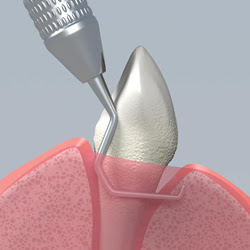
Scaling removes plaque and tartar from below the gum line.
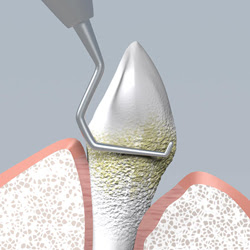
Root planing smoothes the tooth root and helps the gums reattach to the tooth.
Periodontal Surgery
If the pockets do not heal enough after scaling and root planing, periodontal surgery may be needed. Surgery allows the dentist to remove tartar and plaque from hard-to-reach areas. Then the gums are stitched into place to hug the teeth tightly. Surgery can reduce pocket depth and make it easier to keep teeth clean.
If bone has been damaged by periodontal disease, surgery may be needed to rebuild or reshape the bone. Splints, bite guards or other appliances may be used to hold loose teeth in place and to help tissues heal. If too much gum or bone tissue has been lost, the dentist may do a gum or bone graft.
The dentist may place a membrane layer at the surgical area to help the gums stay in place while the tooth root re-attaches to the supporting ligament. This is called “guided tissue regeneration.” After surgery, the dentist may apply a protective dressing over teeth and gums and recommend or prescribe a special mouth rinse. Your dentist also may prescribe an antibiotic and pain reliever.
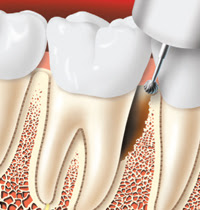
Diseased tissue is removed from the pocket. In some cases, the bone may be reshaped.

The bone has been reshaped.
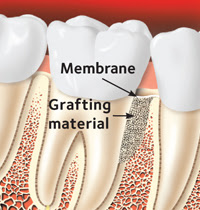
Grafting material is placed over the bone. A membrane covers the grating material.
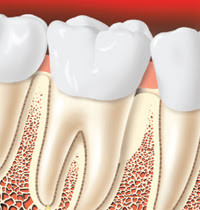
After the healing period.
Care After Treatment
Once your periodontal treatment is completed, your dentist may recommend more frequent checkups and cleanings. Regular dental visits and deep cleanings are important to keep periodontal disease under control. In some cases, your appointments may alternate between your general dentist and periodontist.
Oral Hygiene at Home
Good oral hygiene at home also is very important to help keep periodontal disease from becoming more serious or from coming back. Daily home cleaning helps keep plaque under control and reduces tartar buildup.
- Brush your teeth twice a day with a fluoride toothpaste.
- Floss your teeth (or use another between-the-teeth cleaner) once a day.
You don’t have to lose teeth to periodontal disease. Brush, clean between your teeth, eat a healthy diet, and visit your dentist regularly for a lifetime of healthy smiles.




